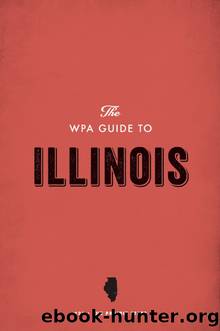The WPA Guide to Illinois by Federal Writers' Project

Author:Federal Writers' Project
Language: eng
Format: epub
ISBN: 9781595342119
Publisher: Trinity University Press
POINTS OF INTEREST IN ENVIRONS
International Harvester Company Plant, 5 m.; East Moline State Hospital, 5 m.; Campbellâs Island State Park, 5 m. (see Tour 14).
SPRINGFIELD
Railroad Stations: Third St. between Washington and Jefferson, for Alton R. R., and Baltimore & Ohio R. R.; Madison St. between Fifth and Sixth Sts. for Illinois Central System. Fifteenth St. and North Grand Ave., for Chicago & Illinois Midland Ry.
Electric Interurban Station: 2015 Clear Lake Ave. for Illinois Terminal.
Bus Stations: Union Bus Station, 611 East Jefferson St., Black Hawk Lines, Greyhound Lines, Santa Fe Trailways, Western Coach Lines, Illinois Transit Lines and Central Illinois Bus Lines.
City Buses: 10c, 2 tokens 15c.
Taxis: Intra-city rates 25c, 1-5 passengers.
Street Numbering: Starting with number 100, East and West from First St.; North and South from Washington St.
Accommodations: 9 hotels; numerous tourist camps on outskirts of city.
Information Service: Springfield Chamber of Commerce, 406 S. Fifth St.
Radio Stations: WCBS (1420 kc.) and WTAX (1210 kc.).
Motion Picture Houses: 11.
Golf: Municipal links at Bunn, Bergen, and Pasfield Parks.
Swimming: Soldiers Memorial Pool, Ninth St. and Converse Ave.; Y.M.C.A., 317 South Seventh St.; Y.W.C.A., 425 South Fifth St.; Lake Springfield Beach, admission 10c, towel 10c, suit 10c.
Tennis: Municipal courts at Washington Park, Lincoln Park, Lanphier Park, and Lake Springfield.
Bridle Paths: Washington Park, West South Grand Ave., 5 miles of path.
Annual Events: Illinois State Fair, State Fair Grounds, eight days, Sat. to Sat., during the last half of Aug.
SPRINGFIELD (71,864 pop., 598 alt.), capital of Illinois, and the Stateâs fifth largest city, lies some 20 miles west of the geographic center of the State. From the softly rolling prairies that stretch for miles in all directions the dome of the Capitol can be seen, announcing Springfield long before the first scattered homes come into view. Large farms, shadowed here and there with a mine tipple, extend to the cityâs door. For Springfield, capital of a farming and coal mining State, reflects its basic industries.
The city proper manifests both the well-ordered spaciousness typical of capital cities, and the disorder of smokestacks and railroad yards that attend factories and mines. Ninth Street, a north and south thoroughfare paralleling a railroad, divides Springfield roughly into capital and industrial areas. West of Ninth Street lie the business section, the great landscaped quadrangle of State buildings that center on the Capitol, and the wide shaded streets of fine houses that border and stem from the State group. Elast of Ninth Street are the bulk of Springfieldâs industrial plants and railroad yards, and the homes of 3,324 Negroes.
No other city in the United States, with the possible exception of Washington, D. C., is such a tribute in itself to a national hero. More than three-quarters of a century ago Lincoln left here for Washington, never to return alive, and at the old Great Western station told a farewell party, âMy friends, no one not in my situation can appreciate my feelings of sadness at this parting. To this place and the kindness of this people I owe everything. Here I have lived a quarter of a century, and have passed from a young to an old man.
Download
This site does not store any files on its server. We only index and link to content provided by other sites. Please contact the content providers to delete copyright contents if any and email us, we'll remove relevant links or contents immediately.
| Africa | Americas |
| Arctic & Antarctica | Asia |
| Australia & Oceania | Europe |
| Middle East | Russia |
| United States | World |
| Ancient Civilizations | Military |
| Historical Study & Educational Resources |
Machine Learning at Scale with H2O by Gregory Keys | David Whiting(4172)
Never by Ken Follett(3788)
Fairy Tale by Stephen King(3216)
The Man Who Died Twice by Richard Osman(2995)
Oathbringer (The Stormlight Archive, Book 3) by Brandon Sanderson(2871)
Will by Will Smith(2790)
Rationality by Steven Pinker(2290)
The Dark Hours by Michael Connelly(2243)
Can't Hurt Me: Master Your Mind and Defy the Odds - Clean Edition by David Goggins(2225)
The Dawn of Everything: A New History of Humanity by David Graeber & David Wengrow(2122)
Friends, Lovers, and the Big Terrible Thing by Matthew Perry(2116)
Principles for Dealing With the Changing World Order: Why Nations Succeed and Fail by Ray Dalio(1969)
HBR's 10 Must Reads 2022 by Harvard Business Review(1776)
A Short History of War by Jeremy Black(1758)
Go Tell the Bees That I Am Gone by Diana Gabaldon(1685)
515945210 by Unknown(1599)
A Game of Thrones (The Illustrated Edition) by George R. R. Martin(1587)
Kingdom of Ash by Maas Sarah J(1521)
443319537 by Unknown(1466)
